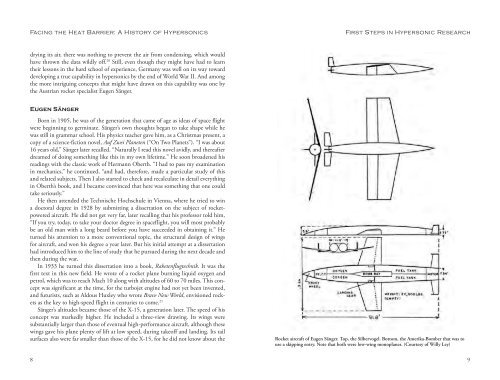Facing the Heat Barrier - NASA's History Office
Facing the Heat Barrier - NASA's History Office
Facing the Heat Barrier - NASA's History Office
Create successful ePaper yourself
Turn your PDF publications into a flip-book with our unique Google optimized e-Paper software.
<strong>Facing</strong> <strong>the</strong> <strong>Heat</strong> <strong>Barrier</strong>: A <strong>History</strong> of Hypersonics<br />
drying its air, <strong>the</strong>re was nothing to prevent <strong>the</strong> air from condensing, which would<br />
have thrown <strong>the</strong> data wildly off. 20 Still, even though <strong>the</strong>y might have had to learn<br />
<strong>the</strong>ir lessons in <strong>the</strong> hard school of experience, Germany was well on its way toward<br />
developing a true capability in hypersonics by <strong>the</strong> end of World War II. And among<br />
<strong>the</strong> more intriguing concepts that might have drawn on this capability was one by<br />
<strong>the</strong> Austrian rocket specialist Eugen Sänger.<br />
Eugen Sänger<br />
8<br />
First Steps in Hypersonic Research<br />
Born in 1905, he was of <strong>the</strong> generation that came of age as ideas of space flight<br />
were beginning to germinate. Sänger’s own thoughts began to take shape while he<br />
was still in grammar school. His physics teacher gave him, as a Christmas present, a<br />
copy of a science-fiction novel, Auf Zwei Planeten (“On Two Planets”). “I was about<br />
16 years old,” Sänger later recalled. “Naturally I read this novel avidly, and <strong>the</strong>reafter<br />
dreamed of doing something like this in my own lifetime.” He soon broadened his<br />
readings with <strong>the</strong> classic work of Hermann Oberth. “I had to pass my examination<br />
in mechanics,” he continued, “and had, <strong>the</strong>refore, made a particular study of this<br />
and related subjects. Then I also started to check and recalculate in detail everything<br />
in Oberth’s book, and I became convinced that here was something that one could<br />
take seriously.”<br />
He <strong>the</strong>n attended <strong>the</strong> Technische Hochschule in Vienna, where he tried to win<br />
a doctoral degree in 1928 by submitting a dissertation on <strong>the</strong> subject of rocketpowered<br />
aircraft. He did not get very far, later recalling that his professor told him,<br />
“If you try, today, to take your doctor degree in spaceflight, you will most probably<br />
be an old man with a long beard before you have succeeded in obtaining it.” He<br />
turned his attention to a more conventional topic, <strong>the</strong> structural design of wings<br />
for aircraft, and won his degree a year later. But his initial attempt at a dissertation<br />
had introduced him to <strong>the</strong> line of study that he pursued during <strong>the</strong> next decade and<br />
<strong>the</strong>n during <strong>the</strong> war.<br />
In 1933 he turned this dissertation into a book, Raketenflugtechnik. It was <strong>the</strong><br />
first text in this new field. He wrote of a rocket plane burning liquid oxygen and<br />
petrol, which was to reach Mach 10 along with altitudes of 60 to 70 miles. This concept<br />
was significant at <strong>the</strong> time, for <strong>the</strong> turbojet engine had not yet been invented,<br />
and futurists, such as Aldous Huxley who wrote Brave New World, envisioned rockets<br />
as <strong>the</strong> key to high-speed flight in centuries to come. 21<br />
Sänger’s altitudes became those of <strong>the</strong> X-15, a generation later. The speed of his<br />
concept was markedly higher. He included a three-view drawing. Its wings were<br />
substantially larger than those of eventual high-performance aircraft, although <strong>the</strong>se<br />
wings gave his plane plenty of lift at low speed, during takeoff and landing. Its tail<br />
surfaces also were far smaller than those of <strong>the</strong> X-15, for he did not know about <strong>the</strong> Rocket aircraft of Eugen Sänger. Top, <strong>the</strong> Silbervogel. Bottom, <strong>the</strong> Amerika-Bomber that was to<br />
use a skipping entry. Note that both were low-wing monoplanes. (Courtesy of Willy Ley)<br />
9
















